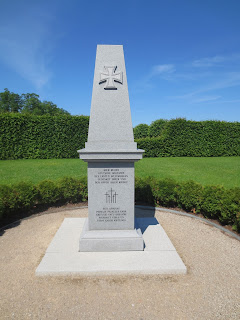After exploring the city's old town and river front we decided to head to Latvia's country side. Our destination was about 1 hour from Riga. Just outside the village of Bauska there is a large palace called Rundāle Palace. Rundāle Palace was build for the Duke and Duchess of Courland in 1730. After Courland was annexed by the Russian empire the palace was given as a gift by Catherine the Great to Count Valerian Zubov, the youngest brother of one of her lover, Prince Platon Zubov. I imagine it must have been nice to know people is really high places. Although I was interested in exploring this beautiful bulding I had another reason for visiting this place.

As I wondered around the hall one of the interesting things I encountered was a few small reminders of the palace's past as a Great War hospital. In one of the rooms if you know where to look there are the names of both Russian and German soldier's carved into the wall's plaster
These names were carved in all likelihood by boarded soldiers trying to pass the time while recovering from their wound's
The below carving is particularly impressive. The soldier who did this must have had some time on his hands. There are a lot of details in this carving, from the lugs on his M16 helmet, his puttees down to the buttons on the 1910 tunic.
I asked one of the workers if they could tell me where the operating theater has been located but they were unsure. I was able to learn that the palace gardens did have a German Great War cemetery. This would have been where soldier who had died while being treated for their wounds at the palace were laid to rest. Sadly I learned that during the Latvian war for independence in 1919 the Palace was sacked and the cemetery was destroyed. Some fragments of the grave stones were located during the renovation of the palace gardens, and were saved. They are now on dispaly in the Palace basement.
I went out to the gardens to see if I could locate the spot where the cemetery had once stood. After a little searching I located the spot. It now has a small monument built where the remains of a number of German and a few Russian soldiers are buried.
On each side of the monument are the names of the German soldiers and units which they fought in. There are also the dates of both birth and death.
Although Rundāle Palace is not a battlefield it does serves as a reminder of the many men who fought and died on the Eastern Front during the Grear War.











No comments:
Post a Comment